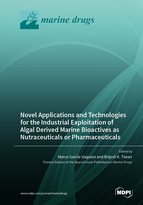Novel Applications and Technologies for the Industrial Exploitation of Algal Derived Marine Bioactives as Nutraceuticals or Pharmaceuticals
A special issue of Marine Drugs (ISSN 1660-3397).
Deadline for manuscript submissions: closed (25 February 2022) | Viewed by 36823
Special Issue Editors
Interests: natural product chemistry; innovative technology; green technology; functional food; pharmaceuticals; antioxidant properties
Special Issues, Collections and Topics in MDPI journals
Interests: novel technologies
Special Issues, Collections and Topics in MDPI journals
Special Issue Information
Dear colleague,
Active molecules or bioactives (i.e. polysaccharides, fatty acids, proteins, polyphenols, diterpenes, steroids and alkaloids) from algae (seaweed and microalgae) have been widely studied in recent years for multiple pharmaceutical and nutraceutical applications. Innovative and emerging technologies including but not limited to ultrasounds, microwaves, electric fields, high-pressure, supercritical fluids, ionic fluids and plasma are currently being explored throughout multiple stages during the pre-treatment, extraction, isolation/purification and preservation of biomolecules from algae. This Special Issue will target research papers, reviews, short communications, and perspectives on the use of novel technologies for the pre-treatment, extraction, isolation-purification, characterization and preservation of marine compounds from algae giving also preference to novel research related to algal bioactives with clear and demonstrated industrial applications and focus.
Dr. Marco García-Vaquero
Prof. Dr. Brijesh K. Tiwari
Guest Editors
Manuscript Submission Information
Manuscripts should be submitted online at www.mdpi.com by registering and logging in to this website. Once you are registered, click here to go to the submission form. Manuscripts can be submitted until the deadline. All submissions that pass pre-check are peer-reviewed. Accepted papers will be published continuously in the journal (as soon as accepted) and will be listed together on the special issue website. Research articles, review articles as well as short communications are invited. For planned papers, a title and short abstract (about 100 words) can be sent to the Editorial Office for announcement on this website.
Submitted manuscripts should not have been published previously, nor be under consideration for publication elsewhere (except conference proceedings papers). All manuscripts are thoroughly refereed through a single-blind peer-review process. A guide for authors and other relevant information for submission of manuscripts is available on the Instructions for Authors page. Marine Drugs is an international peer-reviewed open access monthly journal published by MDPI.
Please visit the Instructions for Authors page before submitting a manuscript. The Article Processing Charge (APC) for publication in this open access journal is 2900 CHF (Swiss Francs). Submitted papers should be well formatted and use good English. Authors may use MDPI's English editing service prior to publication or during author revisions.
Keywords
- nutraceutical
- pharmaceuticals
- cosmeceuticals
- green extraction
- innovative technology
- emerging technology
- purification
- food
- functional food
- nutraceutical
- cosmetic
- pharmaceutical
- ultrasound
- microwave
- electric field
- high-pressure
- supercritical fluid
- ionic fluid
- plasma
- isolation
- purification
- preservation
Related Special Issues
- Novel Applications and Technologies for the Industrial Exploitation of Algal Derived Marine Bioactives as Nutraceuticals or Pharmaceuticals 2.0 in Marine Drugs (2 articles)
- Novel Applications and Technologies for the Industrial Exploitation of Algal Derived Marine Bioactives as Nutraceuticals or Pharmaceuticals 3.0 in Marine Drugs








